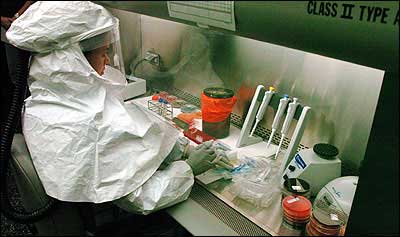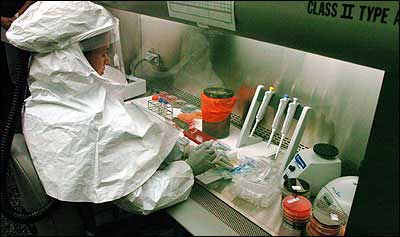State puts bioterrorism labs on display
Scientists demonstrate new, improved equipment
Topeka ? The microbiologist carefully placed the powder on a slide and then into the infrared microscope. A magnified image of the substance appeared on a computer screen, and the machine took a molecular fingerprint and within seconds produced a match: nondairy creamer.
It was only a demonstration, but state officials said Tuesday that at some point in the future, the high-tech microscope may be called on to help analyze something more hazardous.

Carissa Pursell, a microbiologist, wears protective gear as she works at her station. Other safety measures in the lab include a sophisticated ventilation system.
The Kansas Department of Health and Environment allowed a rare peek into its new and improved equipment purchased over the past two years with $2.6 million in federal bioterrorism funds.
Microbiologists and chemists put the machines through their paces, analyzing samples to show how the high-tech equipment worked.
Duane Boline, director of the Environmental State Laboratory, said the grant funds had been used to modernize the lab and increase training to prepare for an emergency and also the day-to-day operations of the agency.
“Every specimen that comes into this lab represents a concern, and the faster we can deal with that … that is one of our main challenges to turn out results rapidly,” Boline said.
The lab includes a machine that can analyze specimens through the amplification of nucleic acids and can be used to identify diseases and bioterrorism agents.
Another machine analyzes samples for metals, such as arsenic in water supplies, while one room is dedicated to testing for West Nile virus, St. Louis equine encephalitis and other diseases.
In another room, a scientist works at a “biosafety cabinet” used for testing samples for possible biological agents. A constant airflow is always moving away from the operator, protecting employees from exposure. The air is vented through filtration systems.
In addition to training for a possible bioterrorism attack, the lab performs thousands of procedures each year, analyzing samples for sexually transmitted diseases, viral diseases and testing public water supplies and remediation site samples.

John Bazhre, a microbiologist in the Parasitology Lab, looks at a specimen on a slide. The Kansas Department of Health and Environment showed off new equipment on Tuesday.








